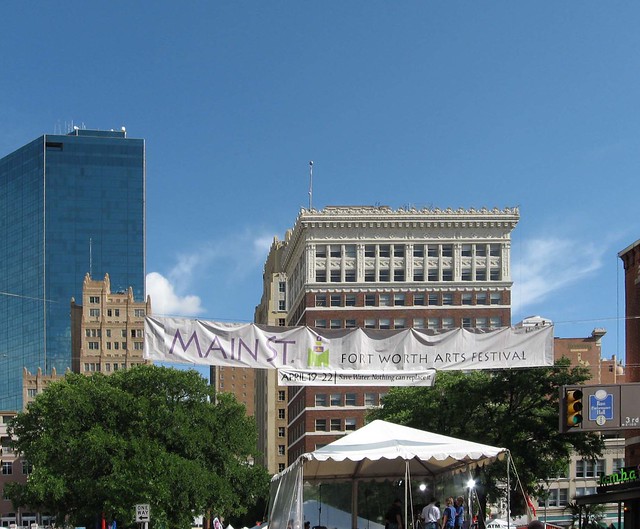 Arts and crafts markets abound like bluebonnets come spring in Texas. The standout among them is undoubtedly the Main Street Fort Worth Arts Festival which just took place last week on Thursday through Sunday. All of the art is juried; for the 2011 show there were over 1,500 applications, and one exhibitor told me there were around 2,000 this year, out of which 200 artists (from all over the country) are selected. Requirements are very stringent as to what can be exhibited and sold (no t-shirts; no postcards, note cards, posters or other offset reproductions; nothing made from kits, patterns, greenware or molds, etc.), ensuring that all work is original and hand-crafted. So everything you see is the crème de la crème. From the breathtakingly beautiful to the amusing and whimsical, there's something for everyone's taste. Perhaps not for everyone's pocketbook, however, as prices reflect the professional quality of the work, although there are unframed art and photography prints, smaller ceramic pieces, and the like. However, looking is free, and the inspiration is, as they say, priceless. At the end of the day, my brain is awhirl with images and ideas and my spirit is soaring (while the rest of me is longing for a good sit-down).
Arts and crafts markets abound like bluebonnets come spring in Texas. The standout among them is undoubtedly the Main Street Fort Worth Arts Festival which just took place last week on Thursday through Sunday. All of the art is juried; for the 2011 show there were over 1,500 applications, and one exhibitor told me there were around 2,000 this year, out of which 200 artists (from all over the country) are selected. Requirements are very stringent as to what can be exhibited and sold (no t-shirts; no postcards, note cards, posters or other offset reproductions; nothing made from kits, patterns, greenware or molds, etc.), ensuring that all work is original and hand-crafted. So everything you see is the crème de la crème. From the breathtakingly beautiful to the amusing and whimsical, there's something for everyone's taste. Perhaps not for everyone's pocketbook, however, as prices reflect the professional quality of the work, although there are unframed art and photography prints, smaller ceramic pieces, and the like. However, looking is free, and the inspiration is, as they say, priceless. At the end of the day, my brain is awhirl with images and ideas and my spirit is soaring (while the rest of me is longing for a good sit-down). Friday, when I went, started off with rain that had some exhibitors scurrying around their booths to protect their work, but thankfully it let up after an hour or so to segue into a cool, cloudy day with sunshine in the late afternoon. And it always seems to be windy downtown, the only thing that mars – only slightly – the experience. Otherwise, Downtown Fort Worth is a delight, never more so than during the festival when the nine blocks of Main Street from the ornate Renaissance Revival Tarrant County Courthouse to the 1960s-contemporary Fort Worth Convention Center are closed to traffic and lined instead with artists' booths and entertainment areas. Greenery and flowers soften the street, setting off its diverse collection of well-preserved architecture. The handsome building facades vie for photographic attention with the exhibits they are temporarily overlooking. Along the street performers enliven the scene with a variety of music. And, of course, there's a plethora of food booths, although I prefer a nice dine-in restaurant for refueling, and Main Street offers plenty of those as well. In short, I love going to this event!
Friday, when I went, started off with rain that had some exhibitors scurrying around their booths to protect their work, but thankfully it let up after an hour or so to segue into a cool, cloudy day with sunshine in the late afternoon. And it always seems to be windy downtown, the only thing that mars – only slightly – the experience. Otherwise, Downtown Fort Worth is a delight, never more so than during the festival when the nine blocks of Main Street from the ornate Renaissance Revival Tarrant County Courthouse to the 1960s-contemporary Fort Worth Convention Center are closed to traffic and lined instead with artists' booths and entertainment areas. Greenery and flowers soften the street, setting off its diverse collection of well-preserved architecture. The handsome building facades vie for photographic attention with the exhibits they are temporarily overlooking. Along the street performers enliven the scene with a variety of music. And, of course, there's a plethora of food booths, although I prefer a nice dine-in restaurant for refueling, and Main Street offers plenty of those as well. In short, I love going to this event! You can take a look at examples of the fabulous work of this year's exhibitors here.
















